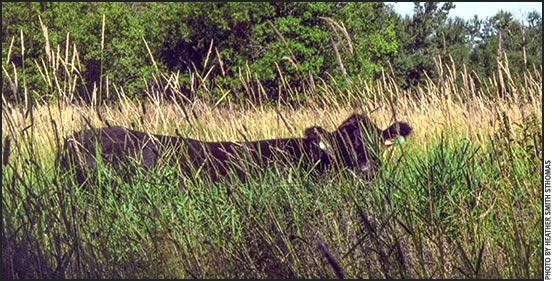
MiG vs. Mob Grazing
Holistic management instructor explains the difference between management-intensive grazing and mob grazing.
A growing number of ranchers are using rotational grazing to get more production from pastures. The management-intensive grazing (MiG) system, for instance, has cattle eating grass while it is still in a vegetative (growing) stage. This gives high animal performance by grazing the plants while nutrient levels are high, before the plants become mature.
“Graziers using this method believe that the only vegetative stage is with a short recovery period, which is what an MiG system does, but with a short recovery period there isn’t much bulk by the time you graze those plants again,” says Ian Mitchell-Innes, a holistic management instructor from South Africa.
He prefers to use a longer recovery period, enabling plants to grow taller and mature at a later date, thus producing more plant mass before going to seed.
“This bulk (carbon, litter or whatever you want to call it) covers the ground and feeds the soil microbes, which improves soil fertility over time, and the grass is less stressed when grazed later,” he explains. If you stress a plant too much, it tries to go to seed quickly to perpetuate the species.
“Grass that’s grazed after just a short recovery period, before it has fully recovered, will try to reproduce quicker; but, as soon as it matures enough to make seeds, it loses the high nutrient quality of the vegetative stage,” he says. Grass stressed by drought or too much grazing won’t grow very tall before it starts going to seed. This creates a shortage of feed in mid-summer heat.
“Mob grazing is different. You allow cattle to graze only the top of the plant in its growing season. Even though cattle tread the rest of the plant down to cover and feed the soil, the grass is not stressed and the period of grazing it in a vegetative stage stretches from 20 days to three months.”
It is still green and growing even though it becomes very tall, with a green understory protected by the canopy of tall grass. The soil is covered at all times, which prevents moisture loss and erosion, and keeps soil temperature more constant. The plants are healthier, the soil is healthier and thus the grazing animals are healthier and more productive.
 Editor's note: Heather Smith Thomas is a freelancer and cattlewoman from Salmon, Idaho.
Editor's note: Heather Smith Thomas is a freelancer and cattlewoman from Salmon, Idaho.





